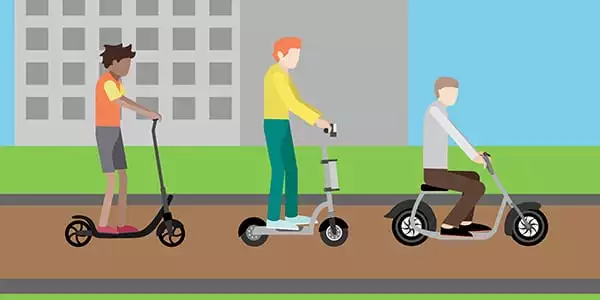What Do Americans Think About E-Scooters in the 30 Biggest US Cities?

Maayan Elkayam
Data Analyst
Jump to
- Introduction
- Americans like e scooters
- But, even though sentiment around e scooters is very positive, Americans are still concerned with the safety of e scooter riders
- The impact of e scooters on public spaces and sidewalk accessibility is still a trending topic, but much less than we expected
- Americans are also still somewhat concerned with pedestrian safety, but barely
- Americans are engaged with how their cities are regulating scooters and they like when e scooter companies and city managers cooperate and share data
- E scooters are here to stay
What Do Americans Think About E-Scooters in the 30 Biggest US Cities?
As e-scooters become more and more prevalent across the US, cities large and small are rising to the challenges and opportunities these micro-modes of transportation provide. Its residents are at the core of a city’s decision-making process in regulating riding. That’s why we decided to round up 2018 by taking stock of how Americans really feel about e-scooters in the 30 biggest cities in the US. We put Zencity’s Artificial Intelligence algorithms to work and ran our data analytics on the key opinion trends of 2018 to understand what people are saying about scooter safety, sidewalk accessibility, city regulation, and data sharing in their cities. This is what we learned.
Introduction
It’s no secret that mobility technology is shifting the way we experience the cities we live in. Over just a few short years, the sharing economy has infused micro-transportation with new energy and possibilities – from the popularization of city-wide bike-sharing platforms to dockless bikes. But arguably, nothing prepared cities for 2018’s global trend: the electric scooter (or e-scooter). E-scooters, like other dockless mobility solutions, are revolutionizing inner-city transportation. However, unlike, for example, city-sponsored bike sharing, e-scooter companies have taken a rather novel approach to their operations strategy. Giving the term “disruptive tech” new meaning, innovative startups like Bird and Lime are private actors literally riding into cities and towns across the country and unloading dozens and sometimes hundreds of strategically positioned scooters across the city. As a result, city managers, mayors, and city council members all have their hands full.
Usually thought of as a hotbed for innovation, cities like San Francisco initially made headline news nationwide as seemingly tech-forward residents rebelled against the scooters, burning them, dumping them into the Pacific, and worse. Instagram accounts, like the aptly named “Bird Graveyard,” are entirely dedicated to the fate that can befall an unloved scooter. So yes, needless to say, e-scooters have certainly been quite a source of controversy in 2018.
But the discourse isn’t all negative and the arguments in favor of e-scooters are also strong. For one, they provide a previously unavailable, quick, and cheap mode of transportation, especially for short distances. Additionally, the e-scooter debate has given rise to discourse on a host of other important urban issues like the accessibility of public spaces, pedestrian safety, and the question of whether the carless future predicted by the tech industry is a feasible reality.

As e-scooters become more and more prevalent across the US, cities are rising to the challenges and opportunities these micros-modes of transportation provide. At the core of their decision-making to regulate riding, work with certain companies and not others, or even ban scooters altogether are, of course, a city’s residents. That’s why we decided to round up 2018 by taking stock of how residents felt about e-scooters in their cities as a full year of these controversial but exciting rides comes to a close. At Zencity, we have fabulous technology that can help us do just this. We’ve put our Artificial Intelligence algorithms to work to assess what Americans had to say about e-scooters in the 30 biggest US cities over the past month. We ran the data analytics on the key trends around e-scooter discourse in 2018 to see what Americans are saying about scooter safety, sidewalk accessibility, city regulation, and data sharing with scooter companies one year in. This is what we learned.

Americans like e-scooters
The discourse surrounding e-scooters was pretty darn positive. We aggregated mentions of e-scooters from social media, including Facebook and Twitter, and ran a sentiment analysis to find that almost half of all social media interactions about e-scooters in the cities we looked at were positive, while only a quarter of the discourse was actually negative. What does this mean? This means that most of the discussions and mentions of e-scooters reflect positive feedback.

But, even though sentiment around e-scooters is very positive, Americans are still concerned with the safety of e-scooter riders
Interestingly enough, the primary concern with e-scooters is not related to their nuisance, as one might have thought even just a few months ago. In fact, these kinds of complaints scored much lower in terms of what people are saying about e-scooters than we expected. Rather, the top concern expressed was about the scooter riders' safety. Discourse covered road safety, including the danger of using bike lanes, riding on sidewalks, and sustaining injuries. Not surprisingly, riders are coming forward and sharing their experiences, like this scooter user in Santa Monica, whose piece made the LA Times and who actually set out to collect experiences of scooter injury earlier this year.
The impact of e-scooters on public spaces and sidewalk accessibility is still a trending topic, but much less than we expected
One of the biggest value adds of the e-scooter is also one of its pitfalls: the fact that it’s dockless. This means that scooters can be picked up and dropped off anywhere – including in the middle of a sidewalk. This has given rise to significant debate and has been a big source of city regulation. Fort Lauderdale, for example, provides guidelines for residents' courteous use of e-scooters but also regulates how e-scooter companies can behave in the city. These regulations require permitting by e-scooter operators and allow the city to fine operators if the scooters have to be moved or stored, which incentivizes companies to make sure that their presence doesn’t negatively impact sidewalk accessibility or city aesthetics. As cities step up regulation, this might explain why, in our data analysis, although certainly one of the issues discussed, the impact of e-scooters on public spaces wasn’t even close to being a leading topic in the overall discourse. Why is this interesting? It shows how the conversation has changed over the course of the year, with sidewalk accessibility certainly originally being one of the strongest sources of backlash against e-scooters.

Americans are also still somewhat concerned with pedestrian safety but barely.
The “e” in e-scooters stands for electric; after all, pedestrians can get injured as scooters go whizzing by. The data we analyzed certainly identified a trend in the discourse on this topic, showing that e-scooters haven’t just injured non-riders and made folks feel less safe, and those folks are talking about their experiences. Altering negative perceptions of pedestrian safety so that pedestrians feel less threatened by e-scooters is a challenge that cities will have to overcome, especially as this concern parallels rider safety. Safety concerns have even made the medical community wary. When you layer sidewalk accessibility onto this, things get complicated. As cities get on the regulating bandwagon, they’ll have to figure this one out, and lawyers are already engaging in the debate. A quick Google search on the topic of who is responsible for e-scooter injuries returns a list of personal injury firms that have something to say on the matter, and certainly, there will be some interesting case law to geek out on soon.

Americans are engaged with how their cities regulate scooters and like when e-scooter companies and city managers cooperate and share data.
Cities have begun to step in and regulate e-scooter riding and work directly with the startup companies themselves. For example, many cities only allow certain e-scooters to operate on their streets legally. Others have data-sharing policies, leveraging the data e-scooter companies are collecting and then regulating with transparency and incorporating the data to back up decision-making. In response, e-scooter companies have also realized that they need to find better ways to appeal to city governments. Bird, for example, even launched a host of new GovTech products, incentivizing cities to cooperate. The verdict on the winning regulatory approach is still out, but we know that residents are very engaged in the matter. We also know that there’s a lot of controversy because of the sentiment breakdown of discussions on regulation – over 50% expressed negative sentiment. This doesn’t necessarily mean they’re anti-regulation; it means there is criticism and discourse in all directions. We saw conversations ranging from strong support for city regulation to significant criticism of the lack of regulation to criticism of the specific regulation elected by the city.
E-scooters are here to stay.
As we head into 2019, it looks like e-scooters are here to stay. From the public sector, cities are getting on board and finding new ways to cooperate with startups. From the private sector, e-scooters are receiving a lot of support, not just from investors but from the big automotive players as well. And perhaps most importantly, Americans seem to really like e-scooters! As is so often the case when problems fall on the footsteps of city hall, cities are rising to the challenge of regulating scooters to make them safer, to make sidewalks more accessible, and as a result, to make these dockless futuristic rides more and more a part of life-on-the-go in urban America.
%20copy-1.png?width=544&height=120&name=Logo_black%20(1)%20copy-1.png)



